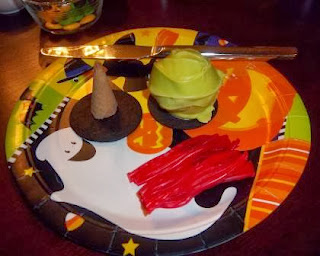If you are brave enough to try this with your kiddoes (or growed-up friends), I would recommend following it up with an activity that let's them run off the sugar rush that follows. You have been warned.
Witchy-Poo Cookie Craft
witch heads
1 pkg. (16 oz.) ready-to-bake sugar cookie refrigerated dough
1 can white icing
1/2 (12 oz.) bag of green candy melts
hats and parts
8 sugar cones (hat tops)
16 thin chocolate wafer cookies (hat brims and collars)
chocolate icing (for hats)
licorice strips, Twizzlers, or sour straws (hair)
chocolate-covered sunflower seeds (for noses)
candy eyes or flat sprinkles (for eyes)
assorted Halloween sprinkles (hat decoration)
For the witch heads, you need to bake the sugar cookies according to the package directions EXCEPT that you want to cook them for the least amount of time listed. The cookies should be on the slightly undercooked side (very chewy, little to no crunchy).
When the cookies are done baking, transfer them to a rack to cool completely.
When the cookies are cool, put them in a food process and run until they are little crumbles.
Mix the cookie crumbles with 1/2 cup of white icing and moosh together until it forms a (not smooth) dough. Because you undercooked the cookies, the crumbles will be moist and dough will be more malleable.
Roll the dough into eight (8) 2" balls. Set on a plate and refrigerate for at least 30 minutes.
When the dough balls are ready, remove from fridge and set aside while you melt the green candy pieces. In a thick bottomed saucepan over low heat (setting 2 or 3) or in a double broiler, stir candy pieces until fully melted and smooth.
Dip the balls in the melted candy and roll around until well-covered. Remove and set each ball on a thin chocolate wafer cookie. Smooth down the chocolate with a butter knife or small spatula. The candy will set within 5-10 minutes.
The only other pre-decorating frenzy prep we did was to pull apart the licorice strips so the girls didn't have to do it. We used Cherry Twizzlers which we cut in half lengthwise and then separated into strands of threes.
It was a fun project and everything is edible. The results were adorable and the girls had a great time building their masterpieces.
We learned the hard way that you want to make sure to put the candy-coated cookie balls on the cookie wafers right away, or at least on a sheet of parchment or wax paper, because the candy coating will start to harden immediately and then need to be pried off the plate that you unwittingly put them on to start with.
If you want different color hair, Punch Straws would work, they have a sugary coating though so won't look the same as the licorice or Twizzlers.
You can usually find chocolate-covered sunflower seeds in specialty stores or grocery stores that stock non-traditional candies. Michelle got hers at Trader Joe's, I believe.
The eye candies and Halloween sprinkles can be found at Michael's or A.C. Moore's craft stores, or any place that sells Wilton products.
Other variations -- use white candy melts and decorate them as vampire heads or instead of cookie balls, make cookie cylinders, cover them with the green candy coating and decorate them as Frankenstein heads. Get creative and go crazy with it, there's no wrong answer here.


















































